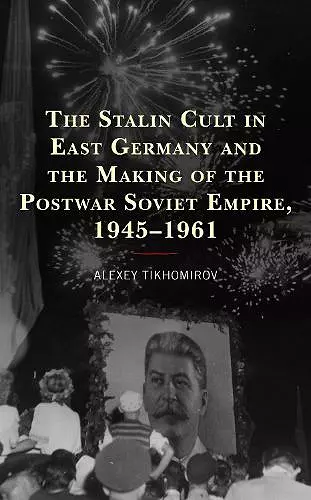The Stalin Cult in East Germany and the Making of the Postwar Soviet Empire, 1945–1961
Alexey Tikhomirov author Jacqueline Friedlander translator
Format:Paperback
Publisher:Bloomsbury Publishing PLC
Published:22nd Aug '23
Currently unavailable, and unfortunately no date known when it will be back
This paperback is available in another edition too:
- Hardback£102.00(9781666911893)

This book examines the construction, dissemination, and reception of the Stalin cult in East Germany from the end of World War II to the building of the Berlin Wall. By exporting Stalin’s cult to the Eastern bloc, Moscow aspired to symbolically unite the communist states in an imagined cult community pivoting around the Soviet leader. Based on Russian and German archives, this work analyzes the emergence of the Stalin cult’s transnational dimension. On one hand, it looks at how Soviet representations of power were transferred and adapted in the former “enemy’s” country. On the other hand, it reconstructs “spaces of agency” where different agents and generations interpreted, manipulated, and used the Stalin cult to negotiate social identities and everyday life. This study reveals both the dynamics of Stalinism as a political system after the Cold War began and the foundations of modern politics through mass mobilization, emotional bonding, and social engineering in Soviet-style societies. As an integral part of the global history of communism, this book opens up a comparative, entangled perspective on the ways in which veneration of Stalin and other nationalistic cults were established in socialist states across Europe and beyond.
Stalin’s cult was a paradox: it should have never existed in a collectivist socialist polity. The export of Stalin’s cult to East Germany, recently liberated from Hitler and his cult by the Red Army, was the ultimate paradox. Alexey Tikhomirov deftly tells the story of where the East German Stalin cult came from, how it was made, and what the population made of it. -- Jan Plamper, University of Limerick
Tikhomirov leads his readers on the remarkable journey that saw East Germans replace the cult of the Führer with the cult of Stalin. His new archival material offers a fascinating glimpse into the East German reception of the myths, symbols, and rituals of communism's preeminent Big Brother. It is always challenging to gauge public opinion in a dictatorship, but it is hard to imagine coming closer to knowing exactly what East Germans made of their new master than we do in this outstanding book. -- Gary Bruce, University of Waterloo
The Stalin Cult in East Germany and the Making of the Postwar Soviet Empire, 1945—1991 offers an entangled history of the unique case of Sovietization in the German Democratic Republic and the transfer of the Stalin cult from the Soviet Union to its former enemy. This monograph is based on a variety of Russian and German archival sources. It analyzes the role of several different historical actors and casts light on both the organization and reception of the Stalin cult in East German society. Finally available in a revised and expanded English version, this book is invaluable for the study of the Soviet mission abroad, not only in East Germany and Eastern Europe, but also for understanding personality cults and communism globally. -- Rósa Magnúsdóttir, University of Iceland
Tikhomirov presents us with a comprehensively researched and carefully analyzed history of the Stalin cult in East Germany, from its foundations in the immediate postwar years to its demise with Khrushchev's de-Stalinization campaign. Particularly notable are his explorations of the shifting social and cultural meanings of the cult and of the iconoclasm that inevitably accompanied it. -- Norman M. Naimark, Stanford University
Tikhomirov’s ground-breaking and highly original research on Soviet propaganda and the Stalin cult in East Germany represents archive-based cultural and social history at its very best. -- Jeremy E. Taylor, University of Nottingham
Alexey Tikhomirov offers an innovative approach to this phenomenon by analyzing the export and reception of Stalin’s cult in East Germany from 1945 to 1961: his method of entangled history opens new vistas. The study is well-grounded in Russian and German archival sources. It has plenty of archival photographs illustrating the indoctrination practices. The methodology that the author selected— entangled history—proved most productive for analyzing a broad range of historical evidence and factors and raised historical research to a new level. * The Russian Review *
ISBN: 9781666911916
Dimensions: 231mm x 154mm x 24mm
Weight: 617g
384 pages